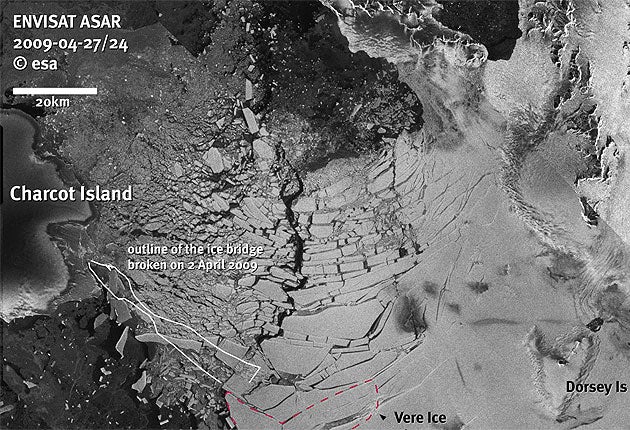Hundreds of miles of ice drop from Antarctic shelf

Your support helps us to tell the story
From reproductive rights to climate change to Big Tech, The Independent is on the ground when the story is developing. Whether it's investigating the financials of Elon Musk's pro-Trump PAC or producing our latest documentary, 'The A Word', which shines a light on the American women fighting for reproductive rights, we know how important it is to parse out the facts from the messaging.
At such a critical moment in US history, we need reporters on the ground. Your donation allows us to keep sending journalists to speak to both sides of the story.
The Independent is trusted by Americans across the entire political spectrum. And unlike many other quality news outlets, we choose not to lock Americans out of our reporting and analysis with paywalls. We believe quality journalism should be available to everyone, paid for by those who can afford it.
Your support makes all the difference.New satellite images from the European Space Agency show massive amounts of ice are breaking away from a shelf on the western side of the Antarctic Peninsula, researchers said today.
The Wilkins Ice Shelf had been stable for most of the last century, but began retreating in the 1990s. Researchers believe it was held in place by an ice bridge linking Charcot Island to the Antarctic mainland.
But the 127-square-mile (330-square-kilometer) bridge lost two large chunks last year and then shattered completely on 5 April.
"As a consequence of the collapse, the rifts, which had already featured along the northern ice front, widened and new cracks formed as the ice adjusted," the European Space Agency said in a statement today on its Web site.
The first icebergs started to break away on Friday, and since then some 270 square miles (700 square kilometers) of ice have dropped into the sea, according to the satellite data.
"There is little doubt that these changes are the result of atmospheric warming," said David Vaughan of the British Antarctic Survey.
"The retreat of Wilkins Ice Shelf is the latest and the largest of its kind," he said, adding that "eight separate ice shelves along the Antarctic Peninsula have shown signs of retreat over the last few decades."
The Wilkins shelf, which is the size of Jamaica, lost 14 percent of its mass last year, according to scientists who are looking at whether global warming is the cause of its breakup.
Average temperatures in the Antarctic Peninsula have risen by 3.8 degrees Fahrenheit (2.5 Celsius) over the past 50 years — higher than the average global rise, according to studies.
Over the next several weeks, scientists estimate the Wilkins shelf will lose some 1,300 square miles (3,370 square kilometers) — a piece larger than the state of Rhode Island, or two-thirds the size of Luxembourg.
One researcher said, however, that it was unclear how the situation would evolve.
"We are not sure if a new stable ice front will now form between Latady Island, Petrie Ice Rises and Dorsey Island," said Angelika Humbert of Germany's Muenster University Institute of Geophysics.
But even more ice could break off "if the connection to Latady Island is lost," she said, "though we have no indication that this will happen in the near future."
In the meantime, researchers said the quality and frequency of the ESA satellite images have allowed them to analyze the Wilkins shelf breakup far more effectively than any previous event.
"For the first time, I think, we can really begin to see the processes that have brought about the demise of the ice shelf," Vaughan said.
Join our commenting forum
Join thought-provoking conversations, follow other Independent readers and see their replies
Comments